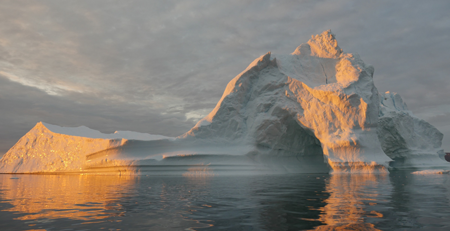Days of our lives are getting longer
Climate change is extending them slightly
Jun 15, 2016 - by Staff
Jun 15, 2016 - by Staff
June 16, 2016 | With the days at their longest this time of year, consider this: They're lingering a tiny bit more because of climate change.
That's because the runoff from melting ice sheets and glaciers is indirectly slowing the planet's rotation. As the water makes its way to the tropics, it redistributes a fraction of Earth's mass from the poles to the equator. The gradual shifting of mass to the planet's widest circumference, where it has to be moved more than 20,000 miles for a full rotation, has the effect of almost imperceptibly slowing Earth's spin. Figure skaters use the same approach, lifting their arms above their heads to accelerate into a spin and extending them outward to slow down.

An iceberg floats in Disko Bay, near Ilulissat, Greenland, on July 24, 2015. Runoff from melting ice sheets and glaciers is shifting the mass of the planet and slightly slowing Earth's rotation. (Photo by Saskia Madlener, NASA.)
To be sure, this change in Earth's rotation is not something that most of us would notice, adding no more than about a couple of thousandths of a second to the length of a day over the course of a century. And it's just one contributor to a long-term slowdown in Earth's spin, which is also affected by the moon's gravitational influence on tides. The 24-hour day may be something we take for granted, but it averaged only about 23 hours during the time of the dinosaurs.
Still, the slowing of Earth's rotation is a sign of climate change's far-reaching and sometimes surprising impacts on our environment.
"The components of our Earth system are connected in ways that are not obvious at first glance," said NCAR climate scientist John Fasullo. "The idea that the warming of the surface can be connected to the length of the day can seem very esoteric. But when you think about it, the strong physical ties become apparent.
"One of the great challenges for scientists is to make these connections and understand how aspects of our environment that seem so different are, in fact, connected with each other," he added.
Indeed, much of the research around NCAR has highlighted unexpected connections among different parts of our physical world. Some examples:
"Understanding how these seemingly disparate processes are connected with each other is critically important to advancing Earth system science," said NCAR Director Jim Hurrell. "Equally important, however, is that this improved understanding is vital for anticipating events that can have enormous consequences for society."
Writer/contact:
David Hosansky, Manager of Media Relations